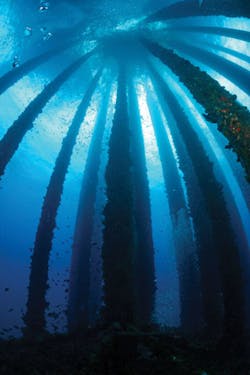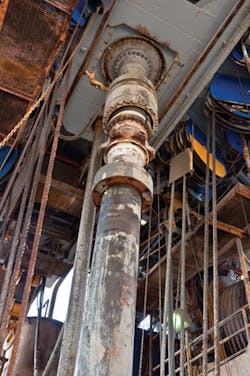Certified agent inspections prove useful in safely maintaining aging risers
Alan Yu • John L. Upchurch
ABS
Considering the vast number of deepwater production risers and their accompanying pipeline systems installed in the last 20 years, the general service record has been exceptional. For the most part, these risers and pipeline systems are not working in high-pressure/high-temperature conditions or in ultra-deepwater, but many of them are reaching the end of their design lives. In the Gulf of Mexico alone, there are at least six production platforms that are at more than 15 years of service life, with 11 having service lives that fall between 11 and 15 years. Many associated riser and pipeline systems are reaching their original design lives (which for most is 20 years), and many more will reach this point in the next five to 10 years.
By and large, risers and pipeline were designed using API RP 2RD and API 1111, both of which are working stress design codes that do not contain provisions that outline how assets owners will address end-of-design-life or how risers and pipelines can safely remain in service beyond that point.
While 30 CFR 250 has requirements for how a certified verification agent (CVA) reviews designs, fabrication, and installation for newbuild risers or risers that need to undergo modification, there is no requirement to do anything for the vast number of risers that do not require modification but are reaching or exceeding their original design lives.
Most of these risers and pipelines were installed without a monitoring system, so there is limited data available for use in determining how much wear or fatigue these assets have experienced during their working lives. Quite possibly, the pristine service records are an indication that the original API RP 2RD design code was too conservative and that the risers and pipelines actually are fit for much longer continued service. Without performance data, however, there is no way to gauge with certainty how much wear they have experienced and how that might affect performance.
Retrieval challenges
Top tensioned risers (TTR) are made of joints that were installed by connecting them into a string offshore, with the bottom end attached to the subsea wellhead and the top ends tensioned. Earlier versions of tensioning devices on spars used buoyancy cans positioned in the center well. More recent methods use long-stroke tensioners similar to those used on TLPs with the tensioner resting on the production deck. TTRs were designed to be able to be taken apart when retrieved offshore.
Some operators have taken the required steps to clean, inspect, and test their TTRs so that - following official permitting by the US Bureau of Safety and Environmental Enforcement - the risers could be re-installed for continued service. Of course, the recipes for getting these retrievable risers recertified for continued service vary from one operator to another. For steel catenary risers that were connected to the pipeline and welded together when installed, retrieval poses an enormous challenge. The only way to retrieve these types of risers is to cut them into pieces or reel them back in. Recovering these risers, inspecting them, testing them, and then re-installing them is a process that is cost prohibitive. The impracticality of this process raises serious questions about how industry deals with these risers when they are approaching their design lives.
Verifying integrity
When risers were being designed, a lot of effort went into predicting their ability to withstand the loads and forces associated with long-term deployment. Strength checking employed computer simulation to predict the extreme and survival loads exerted on the riser systems to determine that loads experienced during the riser’s working life would not cause the riser system to yield or to buckle. Most systems were designed based on identified extreme load cases that were given with a minimum safety factor of 1.25 in the API RP 2RD design code. In fact, the performance of dynamic risers mostly is governed by their fatigue resistance to environmental and operational cyclic loads. Most of the risers in use today were designed using this cumulative damage ratio method.
Simply put, the fatigue design curves were generated by testing many representative riser material samples. The predicted fatigue life of the riser was the duration at which the cumulative damage reached 100%. The general safety factor for fatigue life assessment is 10. To truly understand how much damage a riser has experienced, the cumulative fatigue damage from all sources has to be taken into account. These include vortex induced cyclic loads, vessel motion, induced fatigue, operational effects, and installation cyclic loads.
Looking at the incident-free track record of more than 10,000 riser years of service, it is apparent that this approach to design has served the industry well. The engineering, fabrication, and installation were done with due diligence, and the riser systems have exhibited pristine performance.
While performance to date has been excellent, “the unknown” still presents a challenge. The question surfaces about what comes next. Should nothing be done because of the performance records and because the code does not require asset owners to do anything, or should industry be proactive and begin looking for a practical process that can be applied consistently to determine how these riser and pipeline systems can move safely beyond their design lives?
Bridge to continued service
The past 20 years of environmental loads and service conditions may or may not be indicative of what should be expected in the future, so there has to be a prudent and informed way to deal with continued service. One approach is to follow a process like the one published in API structural integrity management that begins with generating the design document (data), followed by an assessment of the work by a CVA. When these steps have been completed, a field inspection plan is developed that is followed by an examination. The results of the inspection are fed back into the data, and the cycle continues so that the data upon which decisions are being made is current.
When systems are within a few years of the original design life, a certified agency should be involved in reviewing the original design documents, data from field inspections, and updated environmental data. The result of the review will determine whether the systems can continue to be used without interruption or if additional measures are required. The review may simply conclude that a robustly designed system is functioning as it should with a stable production record, stable trending, and that hindcast metocean data are still in line with the original data. With this type of positive result, nothing needs to be done other than updating the fatigue life to reflect the actual “consumed” damage from the original fatigue life. If the review indicates that there are issues, steps would need to be taken to determine the extent of the safety risks and mitigate them.
Current devices on TTRs measure the top tension of the riser and relative stroke to the production deck, production pressure and temperature, and discrete riser lateral acceleration along the risers. Although these measurements can detect issues with the tensioners and riser functionality, they cannot be used to determine whether there is an initial crack that could be of concern. By the time the pressure measurement detects a major leak, a crack has grown through the riser pipe wall. At that point, propagation of the crack through the entire riser cross section could be imminent.
To date, there has never been such an incident, but as a riser system is kept in place beyond its design life, it becomes critically important to ensure that it is inspected, tested, and used according to the design code and execution plan. A reasonable recommendation is to have internal or external subject matter experts and offshore operation teams go through the original design data between years 17 to 20 and review field measurement data, remotely-operated vehicle inspection records and other relevant data, formulate a plan to assess the system, and then revise the inspection plan. The value of this approach is that an inspection plan can guide the future operation team regarding what and how often to inspect the riser and pipeline system. The process continues until the system is decommissioned.
Dealing with refurbishment, conversion
There is a great deal of similarity between the considerations taken into account for riser systems and vessels - the environmental loads, steel as the basic structural material, the need for corrosion protection, and regulatory agencies involved. There are structures on an offshore vessel that can easily be inspected at a dry dock and areas that cannot be accessed easily for inspection. The approach to fleet refurbishment and continuing service or conversion of an asset for another service can be applied by the riser and pipeline industry.
In many cases, the process used to prepare a vessel to sail into its next “life” could be applied to the reuse or repurposing of riser systems. Knowing what is needed to responsibly maintain a floating asset beyond its original design life would be valuable in determining how riser systems could remain in service or be reused for another purpose.
There are industry-accepted procedures in place to refurbish and redeploy various types of floating vessels. The associated methods could provide an algorithm to develop procedures eventually leading to extended service life for risers and even redeployment for other purposes.
Using performance and operational data can help industry get the most value out of existing systems and improve safety in continued operation as those assets age.



